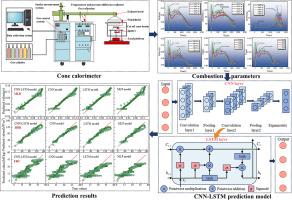Combustion parameter prediction for mining conveyor belts by using convolutional neural network–long short-term memory
IF 9.6
Q1 COMPUTER SCIENCE, ARTIFICIAL INTELLIGENCE
引用次数: 0
Abstract
The combustion characteristic parameters of mining conveyor belts represent a crucial index for measuring the fire performance and hazard posed by combustible materials. An accurate prediction of its value provides important guidance on preventing conveyor belt fires. The critical parameters of a flame–retardant polyvinyl chloride gum elastic conveyor belt were measured under different radiative heat fluxes, including mass loss rate, heat release rate, effective heat of combustion and gas production rates for CO and CO2. The prediction method for the combustion characteristics of conveyor belts was proposed by combining a convolutional neural network with long short-term memory. Results indicated that the peak values of the mass loss, heat release, smoke production and gas production rates of CO and CO2 were positively correlated with radiative heat flux, whilst the time required to reach the peak value was negatively correlated with it. The peak time of the effective heat of combustion occurred earlier. Through deep learning modelling, mean absolute error, root mean square error and coefficient of determination were determined as 2.09, 3.45 and 9.93 × 10−1, respectively. Compared with convolutional neural network, long short-term memory and multilayer perceptron, mean absolute error decreased by 26.92%, 24.82% and 25.09%, root mean square error declined by 27.82%, 29.59% and 29.59% and coefficient of determination increased by 0.05 × 10−1, 0.06 × 10−1 and 0.06 × 10−1, respectively. The findings provide a quantitative reference benchmark for the development of conveyor belt fires and offer new technical support for the construction of early warning systems for conveyor belt fires in coal mines.

基于卷积神经网络的矿用传送带燃烧参数预测
矿用输送带的燃烧特性参数是衡量其防火性能和可燃物危险性的重要指标。准确预测其数值对防止输送带火灾具有重要的指导意义。测定了不同辐射热通量下阻燃聚氯乙烯胶弹性输送带的质量损失率、放热率、有效燃烧热和CO、CO2产气量等关键参数。提出了将卷积神经网络与长短期记忆相结合的传送带燃烧特性预测方法。结果表明,CO和CO2的质量损失峰值、放热峰值、产烟峰值和产气量峰值与辐射热流密度呈正相关,而达到峰值所需的时间与辐射热流密度呈负相关。有效燃烧热峰值时间提前。通过深度学习建模,确定平均绝对误差为2.09,均方根误差为3.45,决定系数为9.93 × 10−1。与卷积神经网络、长短期记忆和多层感知器相比,平均绝对误差分别降低了26.92%、24.82%和25.09%,均方根误差分别降低了27.82%、29.59%和29.59%,决定系数分别提高了0.05 × 10−1、0.06 × 10−1和0.06 × 10−1。研究结果为输送带火灾的发展提供了定量参考基准,并为煤矿输送带火灾预警系统的建设提供了新的技术支持。
本文章由计算机程序翻译,如有差异,请以英文原文为准。
求助全文
约1分钟内获得全文
求助全文
来源期刊

Energy and AI
Engineering-Engineering (miscellaneous)
CiteScore
16.50
自引率
0.00%
发文量
64
审稿时长
56 days
 求助内容:
求助内容: 应助结果提醒方式:
应助结果提醒方式:


